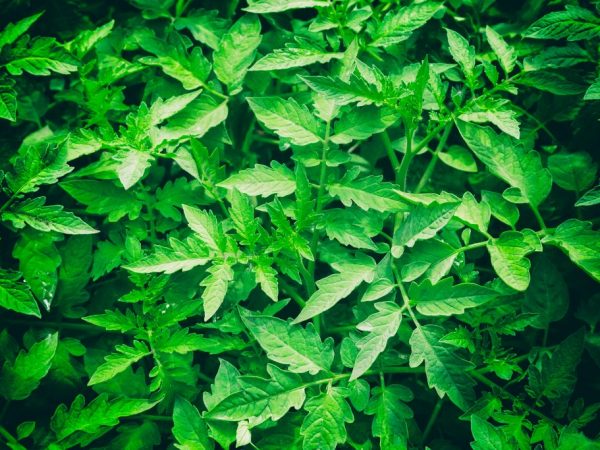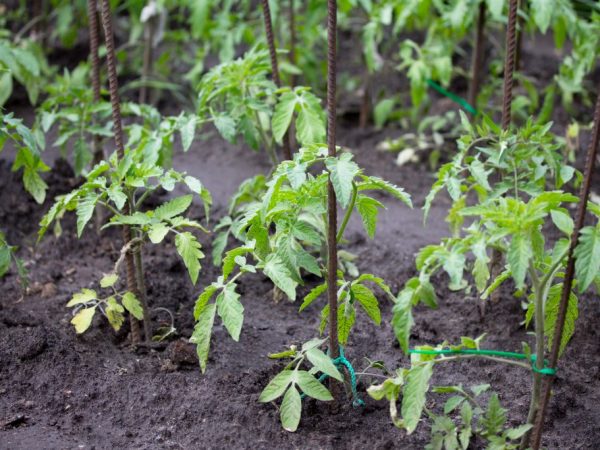What is the reason why the leaves of tomato seedlings fall
Tomatoes are a plant that can cause a number of problems when cultivated. One of them is the weak state of the leaves. Let's look at the reasons why the leaves of tomato seedlings fall off.

Reasons for falling leaves in tomato seedlings
Yellowing and dropping of the lower leaves is the first signal of improper care or violation of agricultural technology. If you immediately find and eliminate the cause, then the plant can be saved.
Causes of leaf fall
There may be several reasons for wilting. The leaves of tomato seedlings fall off due to violations of growing conditions:
- improper watering;
- lack of lighting;
- lack of nutrients in the soil;
- temperature changes;
- fungus in the potting mix;
- damage to the roots when picking or replanting;
- lack of room to grow.
Improper watering
Tomatoes need regular, moderate watering. The lack of moisture, like its excess, leads to the fact that the leaves of the tomato fall off.
It is enough to water a young plant once every 4-5 days. If the room is dry and the ground dries quickly, you can water it once every 2-3 days. The water should be separated and at room temperature. Cold water has a detrimental effect on the delicate roots, microflora and immunity of tomatoes.
If the room is humid, cold or the seedlings are in the shade, then watering can be reduced. Excess moisture leads to decay of the root system, the appearance of fungus in the soil and the disease of all seedlings.
Signs of excess moisture
If the tomatoes turn yellow and shed their leaves due to overflow, then the first step is to inspect the soil. Clean land does not require replacement. You just need to reduce the amount of watering. The presence of plaque, whitish spots or villi, a sour smell indicates that the seedlings should be immediately transplanted into a clean, dry container and into a new soil mixture.
When transplanting, carefully examine the roots of each bush. Healthy white roots. If they are brown, then the seedling is difficult to save - this indicates the beginning of decay.
Sudden changes in watering have a detrimental effect on the seedlings. Periodic underfilling and overflowing becomes stress for young bushes and growth slows down.
Lack of lighting
Tomato is a light-loving culture. Cultivation begins in February - March, when daylight hours are still short. With a lack of lighting, the plants stretch out, the leaves develop poorly, and may begin to turn yellow and fall off. There are two ways to solve the problem:
- Add artificial lighting.
- Grow seedlings in the most lighted window.
Conventional incandescent bulbs are of no use. Better to use LED lights. Their light is ideal for the seedlings.
Tatiana Orlova (Candidate of Agricultural Sciences):
Even on the southern window, the sun is no more than 3-4 hours a day. In this case, plants are illuminated only from one side, the other remains in the shade.To eliminate the lack of light, fluorescent fluorescent lamps are used. They are placed on top of the seedlings at a distance of no more than 1 meter.
Lack of nutrients in the soil

Lack of nitrogen negatively affects plants
Young bushes grow quickly and require regular feeding. Before flowering, plants actively grow green mass. The main building block is nitrogen. It is its lack that leads to yellowing and death of the lower leaves.
It is possible to compensate for the nitrogen deficiency by applying organic fertilizers. It must be remembered that excess nitrogen can have a detrimental effect on future crops. The active growth of leaves, the compaction of the stem indicates that the culture receives sufficient nutrients.
It is recommended to carry out the first feeding in the phase of 3-4 true leaves, the next one after 2 weeks. The last feeding is carried out 10 days before planting.
In addition to nitrogen, copper, potassium, and iron may not be enough. Lack of elements can also cause yellowing and dropping.
Temperature changes
An important role for the normal development of tomatoes is played by the choice of location in the apartment. Seedlings grow well in a warm, draft-free place.
At high temperatures (if the heating season has not ended), the leaves will crumble.
Spring night frosts can also cause significant damage. If the temperature at night falls below 12 ° C, the tomatoes will wither.
Tatiana Orlova (Candidate of Agricultural Sciences):
Prolonged cold snaps are fatal for tomato when the air and soil temperature drops to +10 degrees and lasts 7-10 days. This can lead to the termination of all processes in the plant.
Infection in the potting mix
Sometimes the reason why the lower leaves of tomato seedlings fall off is poor soil. Store-bought potting mix does not always guarantee its quality, and garden mix requires good processing and disinfection before use.
The fungus in the soil appears as mold on the surface. It should not be confused with salt crust. The crust is a whitish, dense coating that no longer appears after removing and adding a fresh portion.
Mold can be caused by:
- waterlogging and poor drainage;
- heavy soil;
- contaminated soil;
- too dense planting of seedlings, insufficient ventilation between plants.
The most radical and effective method of getting rid of the fungus is a complete soil replacement. Mold is difficult to remove and can return quickly. The fungus penetrates through the roots into all parts of the plant and leads to its death.
Tatiana Orlova (Candidate of Agricultural Sciences):
Molds are saprophytic, i.e. organisms that feed on dead organic matter, which is found in large quantities in the seedling soil. But in conditions of a limited volume of soil, they become competitors of higher plants - seedlings or tomato seedlings and suppress their growth.
Before transplanting, the planting containers must be well and thoroughly washed and disinfected. Seedlings must be carefully washed from the remnants of old soil. Those tomatoes that are infected, have rotten roots, cannot be planted. Before planting in the ground, the roots of the seedlings are disinfected in a solution of Fitosporin-M or Fundazol. This will prevent the growth of the fungus.
To prevent the development of a fungus, you need to avoid thickened plantings, carefully monitor the frequency of watering. If necessary, periodically dry the air and ventilate the room more often.
Lack of room to grow
If tomatoes grow in one container for a long time, then the root system will have nowhere to develop. In such a situation, the bush sheds its leaves so as not to overload itself. To avoid this, you need to monitor the size of the tomato and transplant it into containers of appropriate size in time.
It is important to remember that intertwined roots are injured during transplantation.After landing in a new place, they will begin to recover and grow actively, thereby slowing down the development of the aboveground part.
Tatiana Orlova (Candidate of Agricultural Sciences):
Thickened crops are the most common cause of tomato leaf fall. Plants are affected by two negative factors at once - a lack of light (the seedlings are stretched out), a lack of nutrition - the cotyledon leaves turn yellow and are thrown off first, then the lower pair of real leaves.
Diseases and pests
If, following all the recommendations, the tomato leaves still fall off, then insects may be the reason. It is necessary to inspect all seedlings for the presence of pests. If they are found, they are treated with insecticides.
A viral or fungal disease can also provoke a problem. In this case, the bushes should be treated with a fungicide and preventive measures should be followed.
Conclusion
So, we have sorted out for what reasons leaves fall from tomatoes. Compliance with the rules for growing seedlings and providing care for them will help to overcome this problem.



